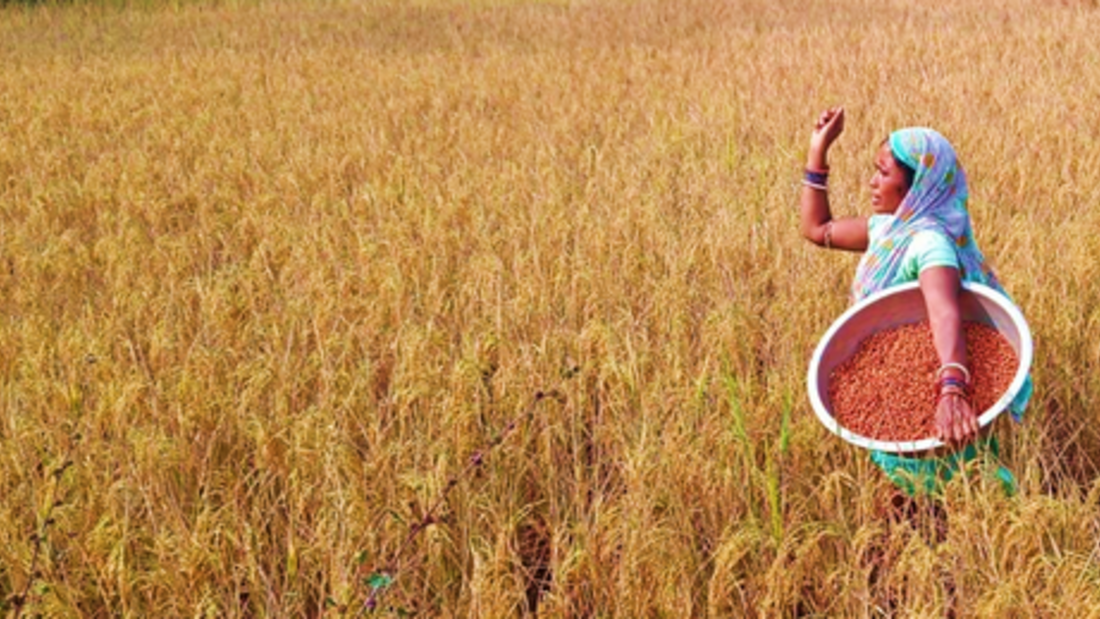December 18, 2024

Grasspea field
Odisha, an agrarian state in Eastern India, is converting agricultural challenges into opportunities by cultivating 0.4 million hectares of rice fallow (land that lies unutilised between rice crops) using innovative agri-technologies and practices, increasing production and improving farmers' incomes. Rice fallow provides an excellent opportunity for planting rainfed crops like pulses and oilseeds. Grasspea, a drought-tolerant legume, stands out as a promising crop in this initiative set in Balangir, a district included under ICARDA's Rice Fallow Project in Odisha.
Unlocking the potential of grasspea in the CRFM Program
With approximately 2.1 million hectares of rice fallow, about 1 million hectares are conducive for growing pulses and oilseeds. Given the challenges in planting extra crops on rice fallow due to climatic and social factors, the Odisha Government launched the Comprehensive Rice Fallow Management (CRFM) Programme during Rabi 2023-24 (India’s spring season), which seeks to address climatic challenges such as limited residual moisture, erratic rainfall, inadequate irrigation infrastructure, and delayed Kharif harvests (harvest time is during India’s monsoon season from June to September). The CRFM also aims to overcome social barriers like seasonal migration, fragmented landholdings, and low farmer awareness, to help transform traditionally uncultivated rice fallow into productive land.
Implemented by ICARDA as a consortium partner in collaboration with the International Rice Research Institute, the CRFM program also promotes Good Agricultural Practices (GAP) that increase cropping intensity, boost pulse and oilseed production, improve soil health, and foster better market linkages.

The marvel of grasspea
Within this program, grasspea has emerged as a crucial crop in rice fallow systems, thriving due to its climate resilience, nutritional value, and additional agricultural use. Resistant to drought and poor soil fertility, it proves valuable for farmers in challenging climates. Despite historical concerns regarding the anti-nutritional Oxalyldiaminopropionic acid (ODAP), which can cause lathyrism (an incurable neurological disorder which manifests as paralysis of lower limbs) in humans when consumed in large quantities, recent breeding advancements by ICARDA have significantly reduced ODAP levels, rendering grasspea safe for human consumption. Besides serving as a food crop processed into dal, rich in protein and homoarginine, grasspea enhances dietary diversity among rural populations.
Moreover, grasspea stover as dry fodder bolsters local dairy and livestock sectors, augmenting farm incomes. As a legume, grasspea also fixes atmospheric nitrogen through symbiotic nitrogen fixation with rhizobia bacteria in its root modules, converting nitrogen into forms usable by plants, which enriches soil fertility, reduces the need for chemical fertilizers, and supports the sustainability of agricultural systems by improving soil health for subsequent crops.
The Balangir Impact: Sowing Grasspea in Rice Fallow
In Balangir district in Odisha, farmers received 105 tons of quality seed of the grasspea variety “Prateek”, known for its low ODAP content (<0.07%), for cultivation on 1750 hectares. Essential inputs for seed treatment, plant protection, and pest management were also distributed. The program organized 24 capacity-building-cum-seed distribution events where farmers were trained on grasspea cultivation and given seeds, benefiting 3167 participants. Two Farmer Field Day events also took place, focusing on good crop management practices.
76 crop-cut events were conducted to assess the ensuing yield, resulting in an average yield of 1123 kg/ha, markedly surpassing India’s national average of 903 kg/ha. This figure underscores the program’s efficacy in attaining superior crop yields and showcases ICARDA’s successful intervention in enhancing productivity on previously uncultivated fallow land. This impressive success also encourages farmers to adopt ICARDA’s new approaches and to spread word about the potential of grasspea on rice fallow for strengthening livelihoods of dryland smallholder communities in Odisha and beyond.
By significantly improving farming practices and yields, the CRFM program in the Balangir district has also contributed to the Sustainable Development Goals addressing poverty, hunger, health, well-being, production, and climate action. The promotion of grasspea cultivation and marketing has proven a sustainable and profitable venture for farmers. By focusing on improved varieties, value addition, and strategic marketing, this initiative has enhanced incomes and contributed to food security.
The increased grasspea production has improved food availability and market supply, reduced livestock fodder costs, and addressed protein malnutrition in farming communities. Additionally, the CRFM program supports sustainable agriculture by boosting yields and enhancing nutritional security with protein-rich grasspea and as grasspea is resilient to harsh conditions while also fixing nitrogen, the project aids climate adaptation and sustainable farming.
A Model for Sustainable Agriculture

The success of the CRFM program, particularly in promoting grasspea in rice fallow, offers a model for sustainable agriculture that is now replicated in other districts of Odisha and beyond. ICARDA will continue to implement and refine transformative agricultural initiatives such as unlocking the potential of underutilized crops and promoting sustainable agriculture, driving meaningful and ecological change through strategic interventions.